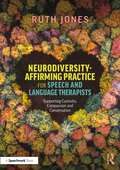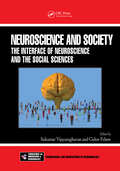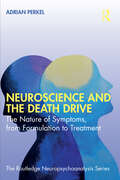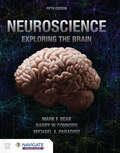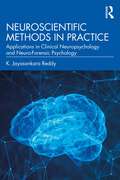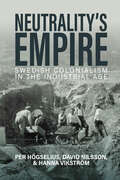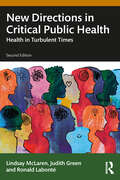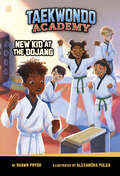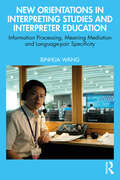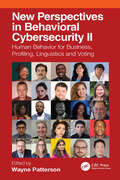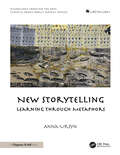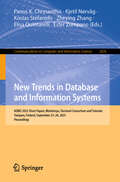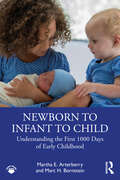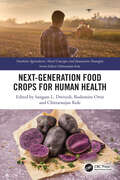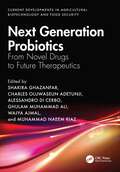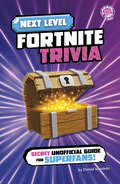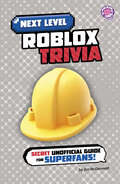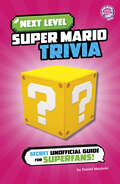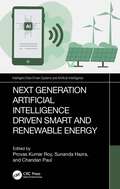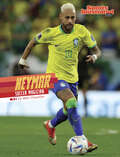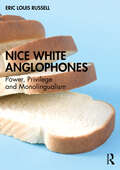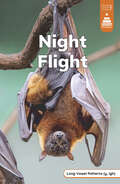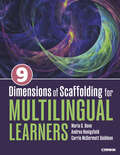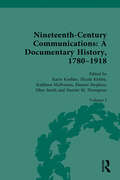- Table View
- List View
Neurodiversity-Affirming Practice for Speech and Language Therapists: Supporting Curiosity, Compassion and Conversation
by Ruth JonesAre you a speech and language therapist (SLT) working independently, within a speech and language therapy team, or in training? Do you, or might you work with autistic or other neurodivergent people? This book will help you understand the changing narrative around how we support neurodivergent individuals, how to sit with complex thoughts and feelings you may have, and how to grow your capacity to unlearn, adapt and shift your values and practice.This essential guide considers what neurodiversity is and what it means to practice in a neurodiversity-affirming way, considering why we should be doing so and, importantly, how to do it. The book moves through the context of neurodiversity in recent times and considers key historical approaches within speech and language therapy. Chapters offer space for reflective practice based on what we know now, for both individual reflection and with colleagues as part of a wider team, before introducing practical strategies to challenge and change how we work with neurodivergent individuals. Throughout, the voices of autistic and ADHD SLTs are included and amplified, sharing their lived experiences and perspectives to further support teams to develop neurodiversity-informed practice.This book offers a safe and supportive space to explore a topic that can be uncomfortable and scary but must be delved into to provide neurodivergent people with access to therapists with knowledge, skills, and advocacy approaches to best meet their needs. It will be crucial reading for all practising and training speech and language therapists.
Neuroscience and Society: The Interface of Neuroscience and the Social Sciences (Frontiers in Neuroscience)
by Sukumar Vijayaraghavan Gidon FelsenAdvances in neuroscience research are rapidly redefining what it means to be human. The absence of the brain/mind dichotomy has, in turn, removed the separation between our brain biology and our sociocultural experiences, raising questions for social sciences to address. How responsible are we, as individuals, for our actions? Do we have free will? Is it ethical for us to peer into others’ brains? How are our collective social cultural norms influenced by our brain function? At the same time, neuroscientists need to develop better intuition about the ethical, legal, and social implications of their research. Close collaboration between neuroscience and social sciences is the best way forward.This book acts as an introduction to these and other issues that lie at the interface of neuroscience and social sciences, using the physiological underpinnings of our decision-making processes as a framework. Examples of topics addressed here are: Neuroscience and economics Neuroscience and law Neuroscience and ethics Neuroscience and mental health Neuroscience of religion and humour The book is intended for students of neuroscience and social sciences, as well as readers generally interested in the human condition. It is hoped that the book will stimulate cross-disciplinary thinking and inspire a new generation of thinkers who are willing to look at both social sciences and neuroscience research with a different lens. Such bridge builders will be the pioneers of the next level of interrogation at this emerging interface.
Neuroscience and the Death Drive: The Nature of Symptoms, from Formulation to Treatment (The Routledge Neuropsychoanalysis Series)
by Adrian PerkelIn this book, Adrian Perkel seeks to expand upon Freud’s theory of the death drive by locating it within modern neuroscience, arguing for the centrality of the aggressive drive in the formation of mind, and the genesis of symptoms and psychopathology. Neuroscience and the Death Drive reformulates the function of defence mechanisms as they link to the aggressive drive and their role in the binding of free energy. Filling an important gap in both formulation and treatment, this book completes Freud’s self-confessed incomplete theory of aggression through the lens of modern psychoanalysis and neuroscience, updating these concepts with current scientific insights, and introduces a refreshed view on psychotherapeutic treatment implications based on these developments. Perkel explores the treatment of patients experiencing eating disorders, anxiety, depression, addiction, personality disorders and sexual dysfunction. This invigorating and approachable book will be of interest to all psychoanalysts, psychiatrists, psychotherapists and counsellors, and will help readers reach new understandings of this key theory of the mind.
Neuroscience: Exploring the Brain
by Michael A. Paradiso Mark Bear Barry ConnorsNeuroscience: Exploring the Brain, Fifth Edition delivers a comprehensive, student-friendly introduction to the structure and function of the nervous system. Updated to reflect the latest research, this edition blends foundational science with engaging, real-world applications, making it ideal for introductory neuroscience or biological psychology courses across a wide range of departments, from psychology to allied health. With an approachable tone, expanded illustrations, and thoughtful pedagogy, this trusted text makes complex topics more accessible, even for students without a strong background in science.The Fifth Edition is distinguished by its clarity, adaptability, and practical relevance. It engages students through clear explanations, relatable scientific stories, and real-world connections, making complex material easier to grasp. Instructors also benefit from features that streamline course planning and support a variety of teaching and learning styles. Updated Content and Illustrations: Chapters reflect new neuroscience research, with improved visuals for improved clarity and engagement.Neuroscience and Medicine Boxes: Highlight the significance of material and connect concepts to real-world medical applications.Path of Discovery Boxes: Firsthand accounts from field experts and Nobel laureates that outline key discoveries and their broader impact.Brain Byte and Brain Food Boxes: Curiosity-sparking sidebars that offer fun facts or deeper dives into select topics to keep students engaged.Student-Focused Pedagogy: Each chapter includes learning objectives, review questions, and a glossary to reinforce understanding.Instructor Resources: Lecture slides, test questions, and chapter outlines that save instructors time and support effective course delivery. © 2026 | 975 pages
Neuroscientific Methods in Practice: Applications in Clinical Neuropsychology and Neuro-Forensic Psychology
by K. Jayasankara ReddyThis book presents an in-depth exploration of the convergence of neuroscience with clinical psychology, clinical neuropsychology, and forensic psychology, examining advanced methodologies, practical applications, and real-world case studies.K. Jayasankara Reddy provides a thorough examination of state-of-the-art neuroscientific methods and the revolutionary effects on both diagnosis and forensic inquiry. Reddy highlights the transformative impact of neuroimaging, neurophysiology, neuroelectrophysiology, and genetic analysis on our comprehension of brain function and behavior, using compelling case examples and empirical evidence. This book not only discusses methods but also critically examines ethical difficulties, merits, and challenges of the techniques, as well as the legal ramifications that may arise from the use of neuroscientific evidence in clinical and forensic settings. This book also highlights the need for a sophisticated comprehension of privacy issues, patient self-governance, and the use of neurobiological information within legal structures.Overall, it provides readers with the tools to negotiate complicated ethical landscapes while responsibly utilizing neuroscientific discoveries, advocating for a balanced approach that combines scientific rigor and ethical responsibility. This volume is an important resource for students, researchers, and practitioners of clinical neuropsychology, forensic psychology, and neuroscience.
Neutrality’s Empire: Swedish Colonialism in the Industrial Age
by Per Högselius David Nilsson Hanna VikströmReconciling Sweden’s reputation for political neutrality and scientific prestige alongside its involvement in extractivist colonial projects exposes uncomfortable overlaps between these seemingly disparate ventures. In this illuminating reappraisal of the intersections between Swedish colonialism and its industrial history, Neutrality’s Empire explores how Swedish actors—ranging from diplomats and business leaders to missionaries, geologists and engineers—leveraged Sweden’s global standing to access valuable mineral resources across Africa and Asia. In doing so, this book presents a historical narrative which clarifies Sweden’s entanglement with the forces of globalization, colonialism, and climate change.
New Directions in Critical Public Health: Health in Turbulent Times
by Judith Green Lindsay McLaren Ronald LabonteIn an era where debates about public health research, policy, and practice are central to the wider socio-political discourse, this invaluable volume brings together key themes from the last 15 years of critical scholarship in and of public health.The book provides both empirical examples and the conceptual tools for rethinking the role of public health in society, challenging the familiar biomedicalized and individualized discourse that has dominated throughout the COVID-19 pandemic. Divided into nine chapters, it covers key topics such as complex systems of health determinants, evidence-making in public health, and the role of corporate actors and philanthropists. Reframing the field through local and global political lenses, New Directions in Critical Public Health: Health in Turbulent Times also integrates interdisciplinary perspectives to provide a truly holistic overview of this rapidly evolving area.It will interest not only students and scholars of public health and the health sciences more widely, but also those in the fields of sociology, political and development studies, and economics.
New Kid at the Dojang
by Shawn PryorWhen a new kid named Julian joins the dojang, Ezra's friends are focused on making the new student feels welcome. They miss Ezra's latest accomplishment: breaking three boards. Feeling jealous, Ezra thoughtlessly dares Julian to try a skill that is beyond Julian's ability. Will Julian's first class at the dojang be his last?
New Orientations in Interpreting Studies and Interpreter Education: Information Processing, Meaning Mediation and Language-pair Specificity
by Binhua WangThis book proposes a multidimensional model that revisits the epistemology of interpreting studies and the distinctive features of interpreting, and outlines three new research orientations.The first considers interpreting as immediate bilingual information processing, the second considers interpreting as meaning mediation in cross-lingual interpersonal communication and cross-sociocultural interaction, and the third looks at language-pair specificity in interpreting. The main research topics, concepts and methods are covered, and case studies and examples are provided. The author also proposes a multicomposite framework of interpreter competence as the conceptual foundation of interpreter education in the AI era, for which three major shifts are identified as necessary, particularly the transition from interpreting skill training to interpreter competence development. The research orientations discussed in this book are important as they shed new light on the nature and mechanism of interpreting, open up new venues for interpreting studies and provide meaningful responses to new issues emerging from changes in the interpreting profession with the development of AI technologies. This is essential reading for all engaged in teaching, researching and studying interpreting and interpreting studies.
New Perspectives in Behavioral Cybersecurity II: Human Behavior for Business, Profiling, Linguistics and Voting
by Wayne PattersonAs the digital world expands and cyber threats grow more sophisticated, the need for insights from diverse disciplines becomes crucial. Following on from the editor's 2023 title New Perspectives in Behavioral Cybersecurity I, this book presents studies covering a wide range of the latest topics in cybersecurity -- from hybrid intelligence in banking security to the connection between physical and cybersecurity attitudes.This volume introduces innovative perspectives from countries as varied as Brazil, Bulgaria, Cameroon, and the Philippines, among others, reflecting the global nature of cyber challenges. New Approaches in Behavioral Cybersecurity II: Human Behavior for Business, Profiling, Linguistics, and Voting brings together international perspectives that explore how human behavior intersects with cybersecurity. The chapters highlight the integration of behavioral sciences such as psychology, economics, and sociology with traditional cybersecurity approaches. Contributors examine linguistic differences in cyberattacks, explore the impact of personality on hacking behavior, and provide insights into ethical practices in the digital age. The reader will be able to take a different and international look at the complex and evolving world of cybersecurity.An ideal read for cybersecurity professionals, human factors practitioners, academics, and students, this book will help readers broaden their understanding of how human behavior influences cyber defenses.
New Storytelling: Learning through Metaphors
by Anna UrsynThere is a global need to become less fearful of coding, as it improves communication with the coders on the job and helps with prompt writing, which hiring companies often request. This set of story-based learning projects links performances and tasks with computing codes to show how a machine translates our goals into its language. Metaphors link instructions telling a computer what task to perform with similar functions in other disciplines. The materials serve those in Computer Graphics, Digital Media, or anyone interested in understanding and becoming familiar with principles and the logic behind coding, and help understand machines when writing a prompt. Dance, music, and performing visually present knowledge through stories and serve as a metaphor for understanding how coding and current technologies affect various disciplines. By introducing basic ideas behind programming in a symbolic way, this book shows how computing and nature overlap through storytelling.Most jobs are collaborative, and coding involves many parts of production processes. These knowledge-based stories improve communication between the artists and the coders to bridge the gap between them.It is a part of the “Knowledge Through the Arts” series, consisting of:Dance Code - Dance Steps as a CodeNew Storytelling - Learning Through MetaphorsCode Appreciation - Reshaping KnowledgeNature Appreciation - Knowledge as Art
New Trends in Database and Information Systems: ADBIS 2025 Short Papers, Workshops, Doctoral Consortium and Tutorials, Tampere, Finland, September 23–26, 2025, Proceedings (Communications in Computer and Information Science #2676)
by Kjetil Nørvåg Panos K. Chrysanthis Ester Zumpano Kostas Stefanidis Elisa Quintarelli Zheying ZhangThis book constitutes short papers, Doctoral Consortium and workshop papers which were presented at the 29th European Conference on New Trends in Databases and Information Systems, ADBIS 2025, which took place in Tampere, Finland, during September 23-26, 2025. This CCIS proceedings book contains 14 short papers and 3 demo papers from the main ADBIS 2025 conference. In addition, 24 out of 48 papers submitted to the workshops are included in this book. The papers have been organized in topical sections as follows: Query Optimization; Spatio-Temporal & Graph Data; Data Sharing & Synthesis; Entity Resolution & Integration; Doctoral Consortium School Invited Talks; MADEISD 2025: 7th Workshop on Modern Approaches in Data Engineering and Information System Design; DOING 2025: 6th Workshop on Intelligent Data - From Data to Knowledge;K-GALS 2025: 4th Workshop on Knowledge Graphs Analysis on a Large Scale; CAIMA 2025: 1st Workshop on Cooperative AI Models and Applications; ERGA 2025: 1st Workshop on Entity Resolution and Graph Alignment; FEHDA 2025: 1st Workshop on Fairness Exploration in Heterogeneous Data and Algorithms; and IT4TOCI 2025: 1st Workshop on Information Technology for Tourism and Culture Industries.
Newborn to Infant to Child: Understanding the First 1000 Days of Early Childhood
by Marc H. Bornstein Martha E. ArterberryThis comprehensive and accessible book introduces child development in the first three years of life. Organized chronologically, the book explores three developmental stages – newborn (birth to 3 months), infant (4 to 17 months), and child (18 to 36 months) – covering physical, perceptual, cognitive, language, emotional, and social development at each stage. The book sets this fundamental information in theories of development, contexts of development, research methods in development, and developmental implications for social policies, applications, and interventions.Key issues, such as the interplay between nature and nurture and interrelations among the several domains of development, are seamlessly integrated throughout. Emphasizing the early years as a unique and critical phase of life, this book features user-friendly elements, like boxes that focus on How Do We Know This? and Application. Presented in full color, the book also defines key terms in a glossary and offers suggested readings.Authored by world-renowned experts in child development, this essential edition is ideal for undergraduate courses in psychology, education, child development, nursing, and social work. It also serves as a valuable resource for professionals in early childhood development and education.
Next Generation Food Crops for Human Health (Nextgen Agriculture)
by Chittaranjan Kole Rodomiro Ortiz Sangam L. DwivediAs the global population surges, the challenge of feeding the world becomes increasingly urgent. Meeting this demand requires doubling crop yields and delivering safe, nutritious, and affordable food, but current agricultural practices fall short in combating malnutrition, climate change impacts, and the decline in food diversity.Next-Generation Food Crops for Human Health delves into the advances in genetic and genomic research that are revolutionizing the development of productive, nutrient-dense food crops. It presents insights into tools including high-throughput phenomics, DNA sequencing, and genomic selection, which enable scientists to discover functionally characterized genes and enhance staple crops, such as grains, legumes, fruits, vegetables, and oil crops. By leveraging these technologies, researchers are creating a new generation of foods that optimize essential nutrients, from complex carbohydrates and proteins to vitamins and bioactive compounds.A volume in the Nextgen Agriculture: Novel Concepts and Innovative Strategies series, this book is valuable to graduate and postgraduate students, postdoctoral researchers, and policymakers working toward improving nutritional security worldwide.
Next Generation Probiotics: From Novel Drugs to Future Therapeutics (Current Developments in Agricultural Biotechnology and Food Security)
by Charles Oluwaseun Adetunji Ghazanfar Shakira Alessandro Di Cerbo Ghulam Muhammad Ali Wajya Ajmal Muhammad Naeem RiazNext Generation Probiotics: From Novel Drugs to Future Therapeutics provides a comprehensive and cutting-edge exploration of probiotics as powerful therapeutic agents. With the rapid advancements in the field, this book offers a deep dive into how probiotics are evolving beyond traditional uses, addressing complex health conditions and diseases in modern medicine. By combining the latest scientific research with practical applications, this book equips researchers, clinicians, and healthcare professionals with the knowledge needed to incorporate probiotics into clinical practice and future therapeutic strategies.The book covers a wide range of essential topics, including: Probiotic mechanisms and the chemical characterization of bioactive compounds derived from probiotics The emerging role of probiotics in gut-brain interactions and psychobiotics for mental health Probiotic-based drug development and their applications in personalized medicine Probiotics in the prevention and treatment of gastrointestinal disorders, metabolic diseases, and cancer The integration of next-generation sequencing and machine learning in optimizing probiotic therapies Probiotics in functional foods and their potential to alleviate lactose intolerance Applications in animal health, focusing on terrestrial and aquatic animals This book stands out by offering an exhaustive examination of probiotics in therapeutic applications, providing real-world examples and insights into how these microorganisms are reshaping modern medicine. Next Generation Probiotics is a must-read for researchers, clinicians, and healthcare professionals interested in the future of probiotics as a therapeutic tool for a wide range of health challenges.
Next Level Fortnite Trivia
by Daniel MauleónReady to take your Fortnite knowledge to the next level? Video game fans can drop in and loot the coolest, most surprising trivia on all things Battle Royale, favorite skins and gear, real-world stats, and more—plus test their know-how with brain-teasing questions. Equipped with a dynamic design and punchy fast facts, this unofficial guide makes it easy (and fun) for young readers and gamers of all skills to level up their island IQ and claim Victory Royale!
Next Level Roblox Trivia
by Jim McDermottReady to take your Roblox knowledge to the next level? Video game fans can unlock the coolest, most surprising trivia on the platform’s wild avatars, most popular games, real-world stats, and more—plus test their know-how with mind-tickling questions. Equipped with a dynamic design and punchy fast facts, this unofficial guide makes it easy (and fun) for young readers and gamers of all skills to level up their Roblox smarts!
Next Level Super Mario Trivia
by Daniel MauleónReady to take your Super Mario knowledge to the next level? Video game fans can collect the coolest, most surprising trivia on the franchise’s iconic characters, storied history, real-world stats, and more—plus test their know-how with brain-busting questions. Equipped with a dynamic design and punchy fast facts, this unofficial guide makes it easy (and fun) for young readers and gamers of all skills to level up their mastery of the Mushroom Kingdom!
Next-Generation Artificial Intelligence Driven Smart and Renewable Energy (Intelligent Data-Driven Systems and Artificial Intelligence)
by Provas Kumar Roy Sunanda Hazra Chandan PaulTo provide for a sustainable future, the potential synergies at the dynamic intersection of renewable energy (RE) incorporated with smart energy and artificial intelligence (AI) must be exploited. RE is crucial to preserve the environment. Energy involving various systems must be optimized and assessed to provide better performance. However, the design and development of RE systems remains a challenge. Advanced optimization techniques, AI, and machine learning (ML) plays a crucial role in implementing the latest innovative research in the field of renewable energy-integrated electrical systems. This book also describes the practical challenges encountered, and the solutions and future scope to be adopted. Applications of a variety of advanced optimization and AI techniques in the design and development of RE-integrated systems are discussed to provide new solutions in the RE domain.Key features: Discusses modern modeling/control approaches for improving renewable energy integrating artificial intelligence-driven power systems Describes the principles and methods of renewable energy generation technologies, and an analysis of their implementation, management, and optimization, and related economic advantages Presents critical information on the technological design and policy issues that must be taken into considered while implementing a smart grid Explains of the metaheuristic optimization algorithm for complex electrical systems, and the whale optimization algorithm-based multi-objective hydrothermal scheduling Covers the electric vehicle charging station in the distribution network, and transient stability constraint optimal power flow problem using chaotic quasi-oppositional chemical reaction optimization The topics covered including microgrids, wind power, solar photo voltaic (PV), optimal power flow (OPF), grid connected inverter, electric vehicle, combined heat and power economic dispatch, FACTS tools for smart energy, harmonic impedance of a salient pole synchronous generator (HI), maximum power point tracking (MPPT) and advanced optimization techniques. Next Generation Artificial Intelligence-Driven Smart and Renewable Energy is ideal for academicians, practitioners, teachers, engineers, industry professionals, researchers, and students in diverse fields, including electrical engineering, electronics and communications engineering, energy, and environmental engineering.
Neymar
by Matt ChandlerAt 17 years old, Neymar made his professional soccer debut. It was a big moment for the boy who grew up playing soccer in Brazil. From there, it didn’t take long for him to become a global superstar. Neymar’s dribbling skills are legendary, and he has scored well over 400 goals in his career. He helped the Brazilian soccer team win their first Olympic gold medal in 2016. Discover more about Neymar’s career and life in this entertaining biography.
Nice White Anglophones: Power, Privilege and Monolingualism
by Eric Louis RussellNice White Anglophones: Privilege, Power and Monolingualism is an innovative work exploring race, power and ideology via an extended fictional case study centring on a monolingual white American family—“The Smiths”. The reader is invited to follow this seemingly “normal” white English-speaking family through their everyday life and think critically about their linguistic and cultural reality, what they do and, especially, what they do not do.What role does monolingual whiteness play in socioeconomics and politics? How do participants in language and culture reinforce dynamics that afford privilege and power to some and exclude others? And how does white monolingualism contribute to the ensmalling our cultural horizons? These themes are introduced through stories and explored in-depth through critical discussion questions, providing comprehensive coverage of monolingualism, race and power in a new and engrossing way.This intersectional work—part textbook, part case study, part dialogue and critical inquiry, is a new and original way to engage students and scholars of language and culture, power and race, as well as anyone interested in monolinguality and languaculture.
Night Flight
by Marley RichmondDuring the day, most bats sleep hanging from caves or trees. At night, bats come alive, navigating with their ears, hunting bugs, and flying through the dark. Beginning readers hone their phonics skills while learning all about bats and their nighttime routines. As readers practice decoding words with the long vowel patterns y and igh, they gain science knowledge. Every Stairway Decodables nonfiction book combines multiple aspects of the Science of Reading to support small group instruction, independent reading, and reading practice at home.
Nine Dimensions of Scaffolding for Multilingual Learners
by Maria G. Dove Andrea Honigsfeld Carrie McDermott GoldmanCreate a rigorous learning environment with strategic and inclusive scaffolding practices Today′s classrooms are more linguistically diverse than ever, but many educators still feel underprepared to support multilingual learners in accessing grade-level academic content. Without intentional scaffolding, these students miss opportunities to thrive alongside their peers. Through nine scaffolded approaches—instructional, linguistic, multimodal, multisensory, graphic, digital, interactive/collaborative, social-emotional, and environmental—this resource offers content area teachers research-based, practical strategies to meet the linguistic, social-emotional, and academic needs of multilingual learners. Key features of this book include Detailed vignettes and authentic examples from classrooms to illustrate scaffolding in action Research-based strategies for integrating scaffolds into lessons across content areas Self-assessment tools and reflection questions for personal and professional growth Practical templates to help educators tailor their scaffolding techniques to individual student needs Scaffolding instruction is not just another teaching approach to learning—it is a critical non-negotiable for multilingual learners, providing a lifeline to language mastery, academic achievement, and a profound sense of belonging. Dove, Honigsfeld, and McDermott Goldman offer the guidance and inspiration educators need to cultivate equitable, engaging learning opportunities that truly help multilingual students to soar.
Nine Dimensions of Scaffolding for Multilingual Learners
by Maria G. Dove Andrea Honigsfeld Carrie McDermott GoldmanCreate a rigorous learning environment with strategic and inclusive scaffolding practices Today′s classrooms are more linguistically diverse than ever, but many educators still feel underprepared to support multilingual learners in accessing grade-level academic content. Without intentional scaffolding, these students miss opportunities to thrive alongside their peers. Through nine scaffolded approaches—instructional, linguistic, multimodal, multisensory, graphic, digital, interactive/collaborative, social-emotional, and environmental—this resource offers content area teachers research-based, practical strategies to meet the linguistic, social-emotional, and academic needs of multilingual learners. Key features of this book include Detailed vignettes and authentic examples from classrooms to illustrate scaffolding in action Research-based strategies for integrating scaffolds into lessons across content areas Self-assessment tools and reflection questions for personal and professional growth Practical templates to help educators tailor their scaffolding techniques to individual student needs Scaffolding instruction is not just another teaching approach to learning—it is a critical non-negotiable for multilingual learners, providing a lifeline to language mastery, academic achievement, and a profound sense of belonging. Dove, Honigsfeld, and McDermott Goldman offer the guidance and inspiration educators need to cultivate equitable, engaging learning opportunities that truly help multilingual students to soar.
Nineteenth-Century Communications: Volume I: Reforming the Mails
by Ellen Smith Karin Koehler Eleanor Hopkins Nicola Kirkby Harriet M. Thompson Kathleen McIlvennaThis volume focuses on the development of mail services between ca. 1780 and 1860. It takes as its starting point John Palmer’s proposal to reform the mail coach system in the 1780s. As part of this volume, the following themes and subjects are covered: Mail services prior to the introduction of the penny post, including the rise and fall of the mail coach; correspondence and surveillance during the Napoleonic wars; the emergence of local penny posts; and debates about the franking privileges of Members of Parliament. Campaigns for and against the introduction of Rowland Hill’s scheme for penny postage between 1837 and 1840. Cultural responses to, and repercussions of, the introduction of the penny post in 1840. The 1844 letter opening scandal. The development of mail infrastructure from 1840 onward, including the development of rural post routes and the use of the railways for the conveyance of the mail.
